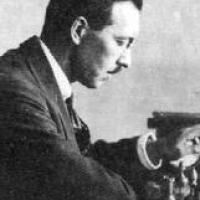
Levenfish Panov-Botvinniks Botvinnik’s Gruenfeld
Now to make sense out of that title containing the names of four players.
Grigory Yakovlev Levenfish was born March 21, 1889 (March 9 at the time in the old calendar) in Piotrkow, Poland in the Russian Empire. He died February 9, 1961 in Moscow, USSR. In 1909, Levenfish won the St. Petersburg Championship. He won the Leningrad Championship in 1922, 1924, and 1925 (tied). He won the Soviet Championship in 1934 (tied) and 1937. Levenfish was the only strong Soviet player among his contemporaries who was not given a stipend by the state. He was also not allowed to compete abroad. He was recognized by FIDE as a grandmaster in 1950, when FIDE began awarding the title. He gave Smyslov his work on rook endings. Smyslov made minor changes and published it as The Theory of Rook Endings by Levenfish and Smyslov (1957 - the same year Smyslov became World Champion by defeating Botvinnik). To this day, nobody should play the Dragon Variation without studying how to play against the Levenfish Variation.
Vasily Panov’s name is used to designate a variation of the Caro-Kann Defense. Botvinnik’s name is also affixed to that variation. I used their names together as a verb to indicate that Levenfish was using that line against Botvinnik, who played the Black side of the Gruenfeld Defense (named after another player). Mikhail Botvinnik was already a world class player campaigning for a chance to win the world championship when he engaged Levenfish, who was 22 years older, in a match. Levenfish was still strong, but was at the end of his prime. The match ended after thirteen games in a tie. The game shown is the final one.
Now to show how the Gruenfeld became a Caro-Kann. The game’s move order was 1.d4 Nf6 2.c4 g6 3.Nc3 d5 4.Bf4 Bg7 5.e3 0-0 6.Qb3 c5 7.cxd5 cxd4 8.exd4 Nbd7. This started as the Gruenfeld Defense. In some places this game is classified with the ECO code of D83, however that would be more appropriate for the line with 7.dxc5. With 7.cxd5, the code B14 is correct. The Caro-Kann move order is 1.e4 c6 2.d4 d5 3.exd5 cxd5 4.c4 Nf6 5.Nc3 g6 6.Qb3 Bg7 7.cxd5 0-0 8.Bf4 Nbd7 and we have the same position. Instead, 6.cxd5 Bg7 7.Qb3 transposes. Chess is a game of patterns and differences. The opening names and move orders are different, but the patterns are the same.
In the game, I have added analysis and game references. Botvinnik shows up in the games. The games are added to the notes where they deviate from the main game, not from their beginnings. Those games had different initial first moves. I believe that Botvinnik could have defended better. Psychological factors can be at play in every game, but these do not show in the game score.

